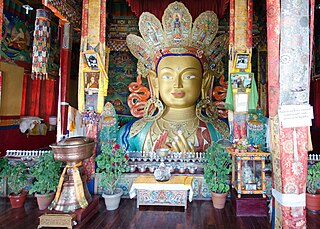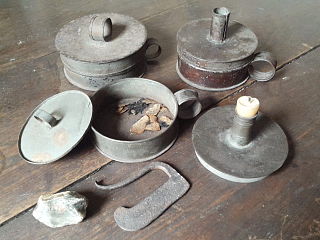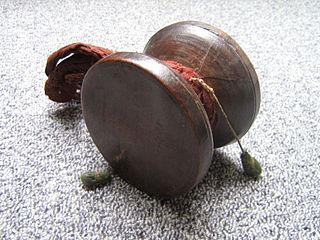
Flint, occasionally flintstone, is a sedimentary cryptocrystalline form of the mineral quartz, categorized as the variety of chert that occurs in chalk or marly limestone. Flint was widely used historically to make stone tools and start fires.

The kukri or khukuri is a type of short sword with a distinct recurve in its blade that originated in the Indian subcontinent. It serves multiple purposes as a melee weapon and also as a regular cutting tool throughout most of South Asia. The kukri, khukri, and kukkri spellings are of Indian English origin, with the original Nepalese English spelling being khukuri.

The Panchen Lama is a tulku of the Gelug school of Tibetan Buddhism. The Panchen Lama is one of the most important figures in the Gelug tradition, with its spiritual authority second only to the Dalai Lama. Along with the council of high lamas, he is in charge of seeking out the next Dalai Lama. Panchen is a portmanteau of Pandita and Chenpo, meaning "great scholar".

Mount Kailash, is a mountain in the Ngari Prefecture, Tibet Autonomous Region of China. It has an altitude of 6,714 m (22,028 ft). It lies in the Kailash Range of the Transhimalaya, in the western part of the Tibetan Plateau. Mount Kailash is less than 100 km north of the western trijunction of the borders of China, India, and Nepal.

A pocket is a bag- or envelope-like receptacle either fastened to or inserted in an article of clothing to hold small items. Pockets are also attached to luggage, backpacks, and similar items. In older usage, a pocket was a separate small bag or pouch.

Tinder is easily combustible material used to start a fire. Tinder is a finely divided, open material which will begin to glow under a shower of sparks. Air is gently wafted over the glowing tinder until it bursts into flame. The flaming tinder is used to ignite kindling, which in turn is used to ignite the bulk material, to produce a fire.

The vast majority of surviving Tibetan art created before the mid-20th century is religious, with the main forms being thangka, paintings on cloth, mostly in a technique described as gouache or distemper, Tibetan Buddhist wall paintings, and small statues in bronze, or large ones in clay, stucco or wood. They were commissioned by religious establishments or by pious individuals for use within the practice of Tibetan Buddhism and were manufactured in large workshops by monks and lay artists, who are mostly unknown. Various types of religious objects, such as the phurba or ritual dagger, are finely made and lavishly decorated. Secular objects, in particular jewellery and textiles, were also made, with Chinese influences strong in the latter.

The flintlock mechanism is a type of lock used on muskets, rifles, and pistols from the early 17th to the mid-19th century. It is commonly referred to as a "flintlock". The term is also used for the weapons themselves as a whole, and not just the lock mechanism.

A tinderbox, or patch box, is a container made of wood or metal containing flint, firesteel, and tinder, used together to help kindle a fire. A tinderbox may also contain sulfur-tipped matches.

A wallet is a flat case or pouch, often used to carry small personal items such as paper currency, debit cards, and credit cards; identification documents such as driver's license, identification card, club card; photographs, transit pass, business cards and other paper or laminated cards. Wallets are generally made of leather or fabrics, and they are usually pocket-sized and foldable.

Amadou is a spongy material derived from Fomes fomentarius and similar fungi that grow on the bark of coniferous and angiosperm trees, and have the appearance of a horse's hoof. It is also known as the "tinder fungus" and is useful for starting slow-burning fires. The fungus must be removed from the tree, the hard outer layer scraped off, and then thin strips of the inner spongy layer cut for use as tinder.

Fire making, fire lighting or fire craft is the process of artificially starting a fire. It requires completing the fire triangle, usually by heating tinder above its autoignition temperature.

A fire striker is a piece of carbon steel from which sparks are struck by the sharp edge of flint, chert or similar rock. It is a specific tool used in fire making.

Char cloth, also called char paper, is a material with low ignition temperature, used as tinder when lighting a fire. It is the main component in a tinderbox. It is a small swatch of fabric made from a natural fibre that has been converted through pyrolysis.

A damaru is a small two-headed drum, used in Hinduism and Tibetan Buddhism. In Hinduism, the damaru is known as the instrument of the deity Shiva, associated with Tantric traditions. It is said to be created by Shiva to produce spiritual sounds by which the whole universe has been created and regulated. In Tibetan Buddhism, the damaru is used as an instrument in meditation practices.

Tibet was a de facto independent state in East Asia that lasted from the collapse of the Manchu-led Qing dynasty in 1912 until its annexation by the People's Republic of China in 1951.

Thokcha are tektites and meteorites which serve as amulets. Typically high in iron content, these are traditionally believed to contain a magical, protective power comparable to Tibetan dzi beads. Most thokcha are made of a copper alloy.

The Sutton Hoo purse-lid is one of the major objects excavated from the Anglo-Saxon royal burial-ground at Sutton Hoo in Suffolk, England. The site contains a collection of burial mounds, of which much the most significant is the undisturbed ship burial in Mound 1 containing very rich grave goods including the purse-lid. The person buried in Mound 1 is usually thought to have been Rædwald, King of East Anglia, who died around 624. The purse-lid is considered to be "one of the most remarkable creations of the early medieval period." About seven and a half inches long, it is decorated with beautiful ornament in gold and garnet cloisonné enamel, and was undoubtedly a symbol of great wealth and status. In 2017 the purse-lid was on display at the British Museum.

This is an alphabetized glossary of terms pertaining to lighting fires, along with their definitions. Firelighting is the process of starting a fire artificially. Fire was an essential tool in early human cultural development. The ignition of any fire, whether natural or artificial, requires completing the fire triangle, usually by initiating the combustion of a suitably flammable material.

Helmet of eight plates in the Korean style is a helmet produced between 14th and 16th centuries in either Korean peninsula or Mongolia. This helmet consists of eight plates made of iron. It is speculated that this helmet style was spread to Korean peninsula from the Tibetan regions. Helmets with similar structure can be seen in Tibet, while both versions of the helmet are made of iron and leather. But Korean-style eight plated helmets are distinguished from those of Tibetan style by its relatively smaller size. Usually a Tibetan-style eight plated helmet measures 21–22 cm in height. But this Korean style helmet measures only 13 cm in height. Currently displayed at the Metropolitan Museum of Art, New York, the Korean style helmet measures 24.3 cm in length and 21 cm in width and 1065.9 g in weight.




















